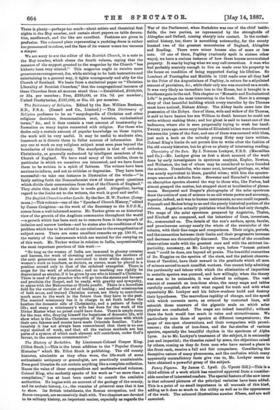Chemistry of the Sun. By J. Norman Lookyer, F.R.S. (Macmillan
and Co.)—Mr. Lockyer gives us first a short account of the work done by early investigators in spectrum analysis, Kepler, Newton, and Wollaston, the last of whom may be considered to have founded the science. Fraunhofer, who oame next, invented gratings, or, what was nearly equivalent to them, parallel wires ; with him the spectra. scope assumed a definite form. Brewster and Hersohers researches on absorption spectra showed the way to those who, like Forbes, had almost grasped the matter, but stopped short at localisation of pheno. mena. Becquerel and Draper's photographs of the solar spectrum drew the notice of men of science to an aid whose power and accuracy, superior, indeed, as it was to human instruments, no one could impeach. Foucault and Stokes bring to en end the purely historical portion of the volume. Angstrom actually publishes what Stokes had only thought. The maps of the solar spectrum prepared by Angstrom, Thelon, and Kirchoff are compared, and the behaviour of lines, inversions, deo., commented on. The details of the sum's surface, spots, faculm, and prominences occupy nearly the whole of the remainder of the volume, with their line-maps and comparisons. Their origin, periods, and the connection between their limits and their progressive increase and decrease are theoretically discussed. The record of the countless observations made with the greatest care and with the strictest im- partiality, necessary, as Mr. Lockyer Bays, before "honest patient work " could be done, are beyond all praise. The beautiful researches of Dr. Huggins on the spectra of the stare, and the patient observa- tions of Taochini, have their reward in the gratitude which all men of science accord to such unselfish workers. One cannot help admiring the pertinacity and labour with which the elimination of impurities in metallic spectra was pursued, and how willingly, when the theory was seen to be untenable, it was allowed to collapse. The vast amount of research on iron-lines alone, the many maps and tables carefully compiled, show with what regard for troth and with what equanimity Mr. Lookyer and his fellow-workers build and destroy their hypotheses. The marvellous rapidity of change, and the speed with which currents move, as evinced by contorted lines, will astonish those unaware of the gigantic) scale on which solar physic's are conducted. The maps are indeed beautiful; without them the book would lose much in value and attractiveness. We particularly note those of spectra at different temperatures; the maps of sun-spot observations, and their comparison with promi- nences ; the charts of iron-lines, and the fao-similes of various spectra, especially the beautiful rhythm in the spectrum of Alpha Lyrae. As to Mr. Lockyer's treatment of the subject, it is eminently just and impartial; the theories raised by some, the objections raised by others, coming as they do from men who have earned a place in the front rank, receive a full and fair comparison. Considering the deceptive nature of many phenomena, and the confusion which many apparently contradictory facts give rise to, Mr. Lookyer seems to have obtained a powerful grasp of the subject.


































 Previous page
Previous page